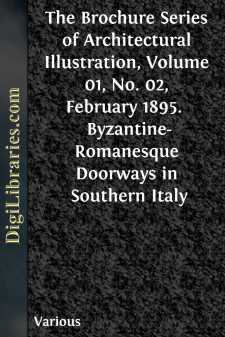Periodicals
- Art
- Children's periodicals 59
- Entertainment 5
- Food/Wine 2
- Games/Humor 455
- General 661
- Health 1
- History 53
- House/Home 1
- Regional 62
- Science/Nature 118
- Transportation 10
Art Books
Sort by:
by:
Various
Abattoirs, 128Aberbrothwick. The Abbey of, 13Aboriginal Races of America. The, 151Accidents:—Fall of a Hotel in Sydney, N.S.W., 184“ “ “ Scaffold, 104“ “ St. Louis Academy of Music, 66“ “ the Roof of the Flora Hall, Hamburg, 196Agreement between Architect and Client, 30Albany Capitol. Defective Gutters on the, 97Aluminium from Bauxite, 194Alva. Statue of the Duke of, 74America. The...
more...
by:
Various
TEA-SMUGGLING IN RUSSIA. The history of smuggling in all countries abounds in curiosities of which but few ever reach the eye of the public, the parties generally preferring to keep their adventures to themselves. There often exist, however, along frontier lines the traditions of thrilling exploits or amusing tricks, recounted by old smugglers from the recollections of their own youthful days or the...
more...
by:
Various
Pulpits of Southern Italy. The pulpits and ambos chosen for the illustrations in this issue of The Brochures are mainly interesting for their wonderful mosaic decorations which are among the finest of their kind which have ever been executed. The work of the family of Cosmati, by whose name the Roman mosaic or inlay of this description is known, such as that in plate LXXI, is similar in design and...
more...
by:
Various
The LORGNETTE, the cleverest book of its kind (we were about to write, since the days of Addison, but to avoid possible disagreement say)—since IRVING and PAULDING gave us Salmagundi, is still coming before us at agreeable intervals, and will soon be issued in a brace of volumes illustrated by DARLEY. The Author keeps his promises, given in the following paragraphs some time ago: "It would be...
more...
by:
Various
BYZANTINE-ROMANESQUE DOORWAYS IN SOUTHERN ITALY. The illustrations chosen for this issue are all from the Byzantine Romanesque work in the province of Apulia, that portion of Southern Italy familiar in school-boy memory as the heel of the boot. Writers upon architecture have found it difficult to strictly classify the buildings of this neighborhood, as in fact is the case with most of the medieval...
more...
by:
Various
GERMAN CRITICISM ON ENGLISH FEMALE ROMANCE WRITERS. We translate the following for the International from a letter dated London, June 15, to the Cologne Gazette. "Among the most remarkable writers of romances in England, three women are entitled to be reckoned in the first rank, namely, Miss Jewsbury, Miss Bronte, and Mrs. Gaskell. Miss Jewsbury issued her first work about four years since, a...
more...
by:
Various
THE COUNTRY HOUSES OF NORMANDY. THE houses chosen for illustration in this number are of different types, of different dates, built for men of different stations in life, and are constructed of different materials. They are, however, all in the province of Normandy, in northern France, and they are all situated outside the towns; further than this it may not be well to go in attempting to classify them...
more...
by:
Various
LITERARY COTERIES IN PARIS IN THE LAST CENTURY. The revolutions of society are almost as sure if not as regular as those of the planets. The inventions of a generation weary after a while, but they are very likely to be revived if they have once ministered successfully to pleasure or ambition. The famous coteries in which learning was inter-blended with fashion in the golden age of French intelligence,...
more...
by:
Various
GEORGE SAND, IN THE MEMOIRS OF CHATEAUBRIAND. George Sand is about to publish a book called "Memoirs of my Life," which is looked for with great expectations by both the admirers of her genius and the lovers of scandalous gossip. It is certain that if she makes a clean breast of her adventures and experiences, the world will have reason both for admiration and disgust over the confessions:...
more...
by:
Various
ITALIAN WROUGHT IRON. The wrought iron of the middle ages, and of the time of the Renaissance, and even down to the last century, in Italy, France, and Germany showed, in the crudest examples, the principal virtues of all true decorative art. The reason is not far to seek. The difficulties in the way of working the material with ease imposed certain limitations in design and execution which could not...
more...











